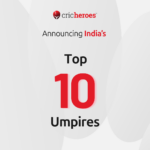
In the dynamic world of cricket, introducing mathematical formulas to determine revised match targets in rain-interrupted games has changed the decision-making process. The DLS Method in Cricket (Duckworth-Lewis-Stern) method and the V Jayadevan (VJD) method stand out as two prominent systems designed to offer fair play under disrupted conditions.
Originally developed by Frank Duckworth and Tony Lewis, the DLS method, previously known as the Duckworth-Lewis method, has been the standard calculation method since its adoption by the International Cricket Council (ICC) in 1999. Steven Stern later refined it, leading to its designation as the Duckworth-Lewis-Stern method, reflecting modern scoring trends and the intricacies of T20 cricket.
Conversely, the VJD Method in Cricket, proposed by V Jayadevan, is a newer alternative that also uses statistical models to predict a fair target but operates on a different set of principles, primarily by using two distinct curves to depict normal and accelerated scoring patterns based on the game’s progress.
Both methods balance the scales when external factors such as weather disrupt play, ensuring that the revised targets are as realistic and fair as possible. The DLS method calculates targets based on the remaining batting resources, which include the number of overs left and the wickets in hand. This method has seen several updates to better address high-scoring games’ complexities and maintain internal consistency within its calculations.
While not as widely adopted as the DLS method, the VJD method offers a unique approach by considering how teams should accelerate their scoring after interruptions, differentiating between the resources already used and those still available.
As cricket continues to evolve with higher-scoring games and more frequent interruptions, the debate over the adequacy of the DLS and VJD methods in providing fair and equitable targets continues. This discussion not only highlights the intricacies of cricket’s rule-making but also underscores the ongoing efforts by the ICC and other cricketing bodies to refine and adapt these mathematical models to keep up with the changing dynamics of the game.

Differences Between DLS and VJD
| Feature | Duckworth-Lewis-Stern (DLS) Method | V Jayadevan (VJD) Method |
| Basis | Uses a statistical approach based on resource percentages left (overs and wickets). | Uses statistical data from past games and adjusts for match situations. |
| Adaptability | Updated periodically to reflect changes in scoring patterns in cricket. | Claimed to be more responsive and better adapted to modern scoring rates. |
| Calculation Complexity | Known for its complexity; involves intricate calculations. | Also complex but designed to be more transparent and realistic. |
| Implementation | Widely used in international matches, including ICC events. | Used in some domestic leagues like the Tamil Nadu Premier League. |
| Reputation Factor | Does not take into account the reputation or historical performance of teams. | Consider the statistics from previous games for a more accurate target. |
| Target Setting | Can sometimes result in unrealistic targets, especially in high-scoring games. | Aims to set more realistic targets in line with current match situations. |
| Acceptance | Officially adopted by the ICC and used globally. | Proposed as an alternative, but not widely accepted internationally. |
Comparative Analysis of DLS and VJD in Matches
Case Studies and Examples
In a notable instance, during a T20 match between India and Australia, the DLS method revised Australia’s score from 158 to 173 based on the assumption that had the rain not interrupted, Australia might have scored around 200 runs in a complete match.
Critics argue that this estimation did not account for the strong bowling performance expected from players like Bumrah and Bhuvi, suggesting that a more realistic score might have been closer to 185. This example highlights a potential area where the DLS method could be refined to more accurately consider the actual conditions and performances during the match.
Conversely, the VJD method has been praised for its more consistent approach to adjusting targets. For instance, in a low-scoring match between Pakistan and South Africa, the VJD system set the target at 226 compared to the DLS method’s 232, reflecting a closer approximation to the on-ground situation.
Pros and Cons of DLS and VJD Methods
| Aspect | DLS Method (Duckworth–Lewis–Stern) | VJD Method (Jayadevan) |
| Pros | – Considers both wickets and overs as resources, providing a balanced approach | – Detailed analysis of scoring patterns, potentially more accurate |
| – Widely used and accepted in international cricket | – Aims to be fairer by considering specific scoring phases | |
| Cons | – Assumes scoring rate increases as innings progresses, which may not always be accurate | – More complex and less intuitive |
| – Reported for potential unfairness in high-scoring games | – Limited usage primarily in Indian domestic tournaments |
Comparison of Mathematical Models
Both methods use complex mathematical models to estimate the most probable score a team could have achieved without interruptions. The DLS method uses a set of curves that estimate scoring patterns based on the overs played and wickets lost, often leading to higher targets during the final overs of the game.
In contrast, the VJD method employs two curves: the normal curve, which adjusts the runs already scored, and the target curve, which calculates the runs yet to be scored, based solely on the overs remaining, regardless of the wickets lost.
This fundamental difference in approach can lead to variations in the target score, especially in matches with frequent interruptions or unusual scoring patterns. For example, the DLS method might set a relatively higher target in a high-scoring game, while the VJD method might offer a target that seems more achievable and fair to the team batting second.
Impact on Match Outcomes

The choice between DLS and VJD methods can significantly impact the outcome of rain-affected matches. For instance, in scenarios where the DLS method might set a steep target based on the assumption of continuous high scoring, the VJD method might calculate a more moderate target, potentially leading to a more competitive and balanced conclusion to the game.
This was evident in a match where the DLS target was adjusted to a higher score based on previous overs’ scoring rate. At the same time, the VJD method provided a lower, arguably more attainable target.
The ongoing debate about the adequacy of the DLS and VJD methods underscores the need for continuous evaluation and adjustment of these systems to ensure they remain fair and relevant in the evolving landscape of international cricket.
Conclusion
Throughout the discourse on the DLS and VJD methods, we’ve navigated the intricate dynamics these systems introduce to the cricketing world, underscoring their ambition to mitigate the disruptions caused by external factors like weather. Exploring each method reveals a shared objective of fairness and realism in revising match targets, albeit through distinct computational lenses.
With its blend of resources—overs remaining and wickets in hand—the DLS method reflects an analytical approach grounded in the game’s evolving scoring patterns. Conversely, the VJD system, through its phase-wise scoring acceleration model, offers a nuanced perspective geared towards capturing the game’s fluid dynamics.
Their comparative analysis illuminates the strengths and areas for refinement within each system. It accentuates the more extensive dialogue on adapting cricket’s regulations to the sport’s changing contours.
While both models strive towards equitable game outcomes, their divergence in calculation and application highlights a crucial aspect of cricket’s ongoing narrative—the quest for a balanced interplay between tradition and innovation.
As the sport evolves, so will the dialogue around these models, inviting a broader discussion on their impact, potential modifications, and the future trajectory of cricket’s regulatory framework. This discourse, integral to the game’s integrity, will undoubtedly benefit from continued scrutiny, analysis, and a greater openness to incorporating advancements that enhance the fairness and excitement of the game
FAQs
- What are the main differences between the DLS and VJD methods in cricket?
The Duckworth-Lewis-Stern (DLS) method primarily focuses on the expected increase in scoring rates as the innings progresses. In contrast, the V Jayadevan (VJD) method incorporates a broader range of data, including past performance statistics of the teams involved, tailored to specific match scenarios.
- How effective is the DLS method?
The DLS method, updated in 2014 by Australian statistician Steven Stern, is tailored to align with modern scoring trends, particularly in T20 cricket. This refinement has made it the preferred standard for addressing rain-affected matches in international cricket.
- What is an alternative to the DLS method?
The V Jayadevan (VJD) method, developed by Indian engineer V. Jayadevan, is an alternative to the DLS method for calculating scores in rain-affected cricket matches.
- Is the Duckworth-Lewis method considered fair?
The Duckworth-Lewis method is the best system for recalculating targets in rain-affected cricket matches. It remains widely accepted once a more comprehensive process is developed considering more variables such as recent team performances and match venues.

I am Manan Joshi , SEO All-Rounder at CricHeroes.
CricHeroes is the ultimate Cricket Scoring App and the world’s only true Cricket Network. With more than 4 crore+ registered cricketers using CricHeroes to Live Cricket Scores for their local cricket matches and tournaments, CricHeroes is already the #1 Cricket Scoring App Globally!
We also proudly present “CricHeroes Store” by CricHeroes, a dedicated shop for cricket apparel and accessories, helping players gear up for their game.















